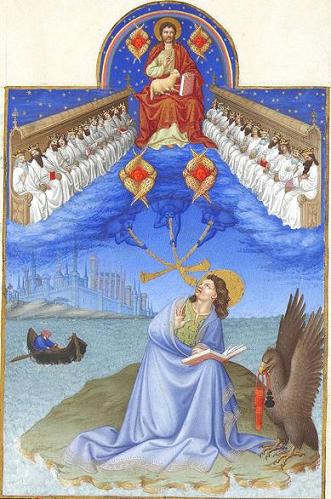
LIFE AS MYTH
![]()
JOURNAL
![]()
JOURNAL 2010
![]()
A vision quest
Finding a guiding light
![]()
AUTUMN 2010
Visions of paradise
![]()
LIFEWORKS
![]()
ATLAS
![]()

AUTUMN 2010
SAINT JOHN
(clockwise) Les Très Riches Heures du duc de Berry, Saint John on the island of Patmos, the vision of the Apocalypse. The Musée Condé, Chantilly. 1410; Saint John on Patmos. Hans Baldung Grien. 1511. Metropolitan Museum of Art, New York. This painting uses as its source a vision of the Virgin Mary described in Revelation 12:1 of the New Testament: A great and wondrous sign appeared in heaven: a woman clothed with the sun, with the moon under her feet and a crown of twelve stars on her head. St. John as an eagle. Book of St. Columba/Kells. ca. 800, Trinity College, Dublin.

In the beginning was the Word, and the Word was with God, and the Word was God. The same was in the beginning with God. All things were made by him; and without him was not any thing made that was made. In him was life; and the life was the light of men. And the light shines in darkness; and the darkness comprehended it not.
John 1:1-5 [KJV]John, also known as the beloved disciple, was a fisherman and a disciple of John the Baptist before joining the ministry of Jesus of Nazareth. The New Testament portrays him as a favorite of Christ, the only disciple who stayed with him during the crucifixion, and the one who promised to honor Christ's request to care for his mother Mary. John was the only disciple to survive into old age, dying of natural causes at the age of 94. He is the patron saint of writers and his feast day is December 27.
According to church tradition, John is the author of several New Testament writings: the Gospel of John, the three Epistles of John and the Book of Revelation. However, there is disagreement among modern scholars as to the authorship of the Book of Revelation. In this debate, there is a distinction drawn between the Apostle John and the John of Patmos, who is the author of Revelation.


